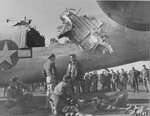drgondog
Major
1943
ETO(B-17/B-24) - MTO(B-17/B-24)
Jan 175/39 - 118/81
Feb 186/69 - 142/65
Mar 502/74 - 167/87
Apr 229/88 - 195/106
May 599/93 - 229/107
Jun 783/51 - 269/192
Jul 820/24 - 314/230
Aug 786/109 - 338/115
Sep 835/96 - 313/204
Oct 907/197 - 298/118
Nov 1166/294 - 268/115
Dec 1302/308 - 289/268
Milosh - You can see how lopsided the B-17 to B-24 ratio was for the 8th through March 1944.
I wonder which B-24 BG's the count shows for B-24s from May though August when all the combat groups (44, 93 and 389) went to Africa for Tidal Wave. The last 8th AF B-24 combat sortie (bombing) was 39 out on May 17 and 34 effectives, then 22 effectives on 7 September after they returned - so none of the Mid May through August B-24 count for 8th AF was flying combat sorties in that period.
It is conceivable some had arrived to start training for the ETO but I would have to check (392, 444, 446 and 448??)


